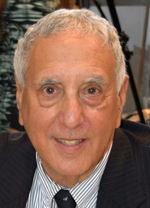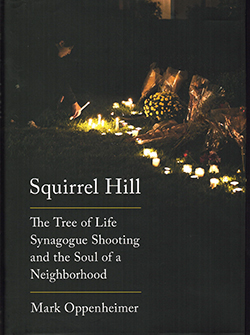Squirrel Hill: The Tree of Life Synagogue Shooting and the Soul of a Neighborhood by Mark Oppenheimer; Alfred A. Knopf © 2021; ISBN 9780525-657194; 261 pages plus acknowledgments, notes on reporting, index and illustration credits; $28.95.
By Donald H. Harrison

 SAN DIEGO – This journalistic tour-de-force tells the story of October 27, 2018, the day an antisemitic gunman snuffed the lives of 11 congregants at the three small congregations that occupied the Tree of Life Synagogue in the Squirrel Hill neighborhood of Pittsburgh, Pennsylvania.
SAN DIEGO – This journalistic tour-de-force tells the story of October 27, 2018, the day an antisemitic gunman snuffed the lives of 11 congregants at the three small congregations that occupied the Tree of Life Synagogue in the Squirrel Hill neighborhood of Pittsburgh, Pennsylvania.
It is not simply a depiction of the carnage, but also a portrait of the community in which it happened. Author Oppenheimer, a former religion columnist for The New York Times, methodically tells us the stories of the victims, including those who barely escaped with their lives, and of the diverse reactions in the community to the shooting. There were those who organized vigils; those who protested a photo-op visit to the synagogue by then President Donald Trump with his wife, Melania, daughter, Ivanka, and son-in-law Jared Kushner. Additionally, there were trauma tourists, compelled perhaps like moths to a flame, who wanted to see the site. There were also presumptuous would-be helpers, who felt they knew better than Squirrel Hill’s residents how the victims should be mourned. And there were fundraisers, who through various appeals including a Go-Fund-Me effort, raised millions of dollars for the families of the victims and for the congregations themselves.
In telling the story of the three congregations that occupied the Tree of Life building – Dor Hadah, New Light Congregation and the Tree of Life’ Or L’Simcha – and the organized efforts of other synagogues and the Jewish Federation of Pittsburgh to rally to their aid, Oppenheimer painted convincing portraits of contemporary American Jewish life.
In this highly readable book, Oppenheimer weaves profiles of Jewish and Christian leaders and lay people whose actions or speeches gave color and definition to the shooting and the recovery process. He also leads us through a year of aftermath, when proceeds from fundraising were allocated without controversy; when the Tree of Life board pondered whether to sell the building and start afresh, or to repair and recondition it as a synagogue, educational institution and memorial. Of special interest to San Diego County readers, he noted the shooting six months later at Chabad of Poway that killed Lori Gilbert Kaye, and wounded three other persons. In Pittsburgh, the event was like the other shoe dropping; confirmation that the Tree of Life massacre was not a one-off event, but rather part of an unfolding horror story of neo-nazi atrocities.
Having interviewed an estimated 250 persons, including most of the survivors of the shooting, Oppenheimer had reams of material with which to work into his story numerous nuances. At the one-year memorial, a planning group had decided that it should be a day of unity, which meant, in their view, no discussion of politics. When one rabbi called emotionally for gun control to stop such mass shootings, many in the crowd cheered him, but others angrily walked out. It was not simply gun collectors, or users, who were offended. Families of the victims felt their wishes for an apolitical observance had been trampled upon, forcing the rabbi to subsequently embark on an apology tour.
Squirrel Hill is one of Pittsburgh’s historic urban neighborhoods, and although Jewish synagogues and institutions have proliferated there, Jews do not constitute a majority. Whereas the identities of other neighborhoods had dissolved with White flight, Jewish families remained in Squirrel Hill, where they were joined by Asian-American and African-American neighbors, many of whom graciously came to the support of the Jewish community. But Oppenheimer noted it was not lost on some African-Americans that the murder of White Jews became the subject of international news, while the murders of Black people frequently were not reported at all.
The overall feeling I got from Oppenheimer’s book was that Squirrel Hill is a special place, where people prefer to get along rather than to prolong controversies. In the Jewish community, this means an acceptance of differences between the Orthodox and non-Orthodox segments of the community; with residents of differing levels of observance greeting and hugging each other at such secular venues as the supermarket. Squirrel Hill residents shared the deep feelings of loss from the shootings, as well as a certain pride in how well the community came together in the face of obscene, violent hatred.
*
Donald H. Harrison is editor of San Diego Jewish World. He may be contacted via donald.harrison@sdjewishworld.com
Thank you, Don, for this excellent review. I have just begun reading the book, am only in the Prologue, but I find it
fascinating. With my granddaughter having been a student at Carnegie Mellon University at that time, my family
was particularly traumatized by the Tree of Life tragedy.